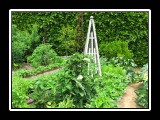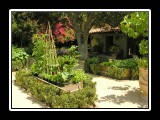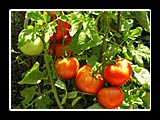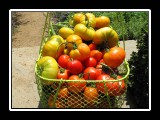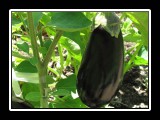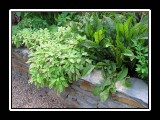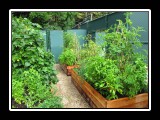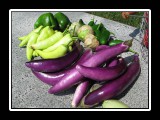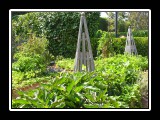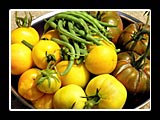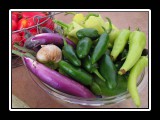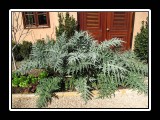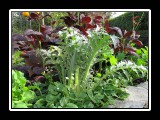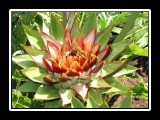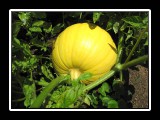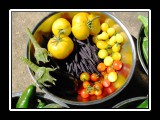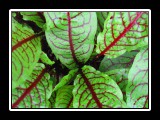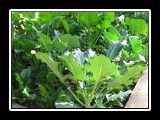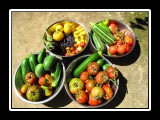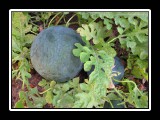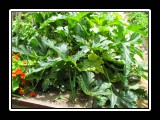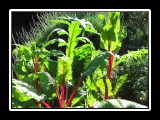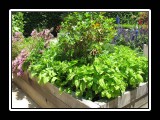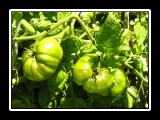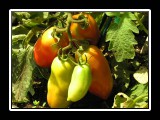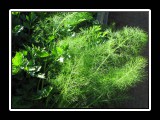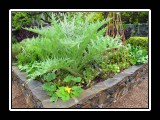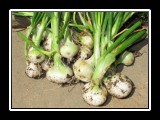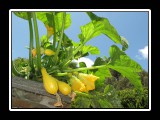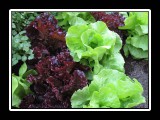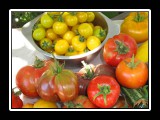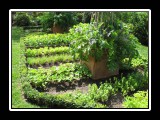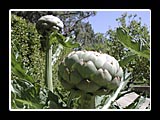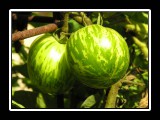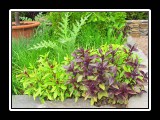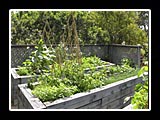Organic
horticulture is the science and
art of growing fruits, vegetables, flowers, or ornamental plants by following
the essential principles of
organic agriculture in soil building and conservation, pest management,
and
heirloom variety preservation.
The Latin words hortus (garden plant)
and cultura (culture) together form
horticulture, classically defined as the culture or growing of
garden plants. Horticulture is also sometimes defined
simply as “agriculture minus the plough.” Instead of the
plough, horticulture
makes use of human labour and gardener’s hand tools, although some
small machine tools like
rotary tillers are commonly employed now.
Mulches,
cover crops,
compost,
manures,
vermicompost, and mineral supplements are soil-building mainstays
that distinguish this type of farming from its commercial counterpart.
Through attention to good healthy soil condition,
[1] it is expected that insect, fungal, or other problems that
sometimes plague plants can be minimized. However,
pheromone traps,
insecticidal soap sprays, and other pest-control methods available
to organic farmers
are also utilized by organic horticulturists.
Horticulture involves five areas of study. These areas
are
floriculture (includes production and marketing of floral crops),
landscape
horticulture (includes production, marketing and maintenance
of landscape plants),
olericulture (includes production and marketing of vegetables),
pomology (includes
production and marketing of fruits), and
postharvest physiology (involves maintaining quality and preventing
spoilage of horticultural crops). All of these can be, and sometimes are,
pursued according to the principles of organic cultivation.
Organic horticulture (or organic gardening) is based
on knowledge and techniques gathered over thousands of years. In general
terms, organic horticulture involves natural processes, often taking place
over extended periods of time, and a sustainable, holistic approach -
while chemical-based horticulture focuses on immediate, isolated effects
and reductionist strategies.
Organic gardening systems
There are a number of formal organic gardening and farming
systems that prescribe specific techniques. They tend to be more specific
than, and fit within, general organic standards.
Forest gardening, a fully organic food production system which dates
from
prehistoric times, is thought to be the world's oldest and most resilient
agroecosystem.
[3]
Biodynamic farming is an approach based on the esoteric teachings
of
Rudolf Steiner. The Japanese farmer and writer
Masanobu Fukuoka invented a
no-till system for small-scale grain production that he called
Natural Farming.
French intensive gardening and
biointensive methods and SPIN Farming (Small Plot INtensive)
are all small scale gardening techniques. These techniques were brought
to the United States by Alan Chadwick in the 1930s.
[4] This method has since been promoted by John Jeavons, Director
of Ecology Action.
[5] A garden is more than just a means of providing food, it
is a model of what is possible in a community - everyone could have a
garden of some kind (container, growing box, raised bed) and produce healthy,
nutritious organic food, a farmers market, a place to pass on gardening
experience, and a sharing of bounty, promoting a more sustainable way
of living that would encourage their local economy. A simple 4' x 8' (32
square feet) raised bed garden based on the principles of bio-intensive
planting and square foot gardening uses fewer nutrients and less water,
and could keep a family, or community, supplied with an abundance of healthy,
nutritious organic greens, while promoting a more sustainable way of living.
Organic gardening is designed to work with the ecological
systems and minimally disturb the Earth’s natural balance. Because
of this organic farmers have been interested in reduced-tillage methods.
Conventional agriculture uses mechanical tillage
[6], which is plowing or sowing, which is harmful to the environment.
The impact of tilling in organic farming is much less of an issue. Ploughing
speeds up erosion because the soil remains uncovered for a long period
of time and if it has a low content of organic matter the structural stability
of the soil decreases. Organic farmers use techniques such as mulching,
planting cover crops, and intercropping, to maintain a soil cover throughout
most of the year. The use of compost, manure mulch and other organic fertilizers
yields a higher organic content of soils on organic farms and helps limit
soil degradation and erosion.
[7]
Other methods can also be used to supplement an existing
garden. Methods such as
composting, or
vermicomposting. These practices are ways of recycling organic matter
into some of the best organic fertilizers and soil conditioner. Vermicompost
is especially easy. The byproduct is also an excellent source of nutrients
for an organic garden.
[8]
Pest control approaches
Differing approaches to pest control
[9] are equally notable. In chemical horticulture, a specific
insecticide may be applied to quickly kill off a particular insect pest.
Chemical controls can dramatically reduce pest populations in the short
term, yet by unavoidably killing (or starving) natural control insects
and animals, cause an increase in the pest population in the long term,
thereby creating an ever-increasing problem. Repeated use of insecticides
and herbicides also encourages rapid natural selection of resistant insects,
plants and other organisms, necessitating increased use, or requiring
new, more powerful controls.
In contrast, organic horticulture tends to tolerate some
pest populations while taking the long view. Organic pest control requires
a thorough understanding of pest life cycles and interactions, and involves
the cumulative effect of many techniques, including:
[10]
• Allowing for an acceptable level of pest damage
• Encouraging predatory beneficial insects to flourish and eat pests
• Encouraging beneficial microorganisms
• Careful plant selection, choosing disease-resistant varieties
• Planting companion crops that discourage or divert pests
• Using row covers to protect crop plants during pest migration periods
• Rotating crops to different locations from year to year to interrupt
pest reproduction cycles
• Using insect traps to monitor and control insect populations
Each of these techniques also provides other benefits,
such as soil protection and improvement, fertilization, pollination, water
conservation and season extension. These benefits are both complementary
and cumulative in overall effect on site health. Organic pest control
and
biological pest control can be used as part of
integrated pest management (IPM). However, IPM can include the
use of chemical pesticides that are not part of organic or biological
techniques.
[11]
Impact on the global food supply
One controversy associated with organic food production
is the matter of food produced per acre. Even with good organic practices,
organic agriculture may be five to twenty-five percent less productive
than conventional agriculture, depending on the crop.
[12]
[13]
Much of the productivity advantage of conventional agriculture
is associated with the use of nitrogen fertilizer.
[12] However, the use, and especially the overuse, of nitrogen
fertilizer has negative effects such as nitrogen runoff harming natural
water supplies and increased global warming.
[13]
Organic methods have other advantages, such as healthier
soil, that may make organic farming more resilient, and therefore more
reliable in producing food, in the face of challenges such as climate
change.
[12]
As well, world hunger is not primarily an issue of agricultural
yields, but distribution and waste. |



